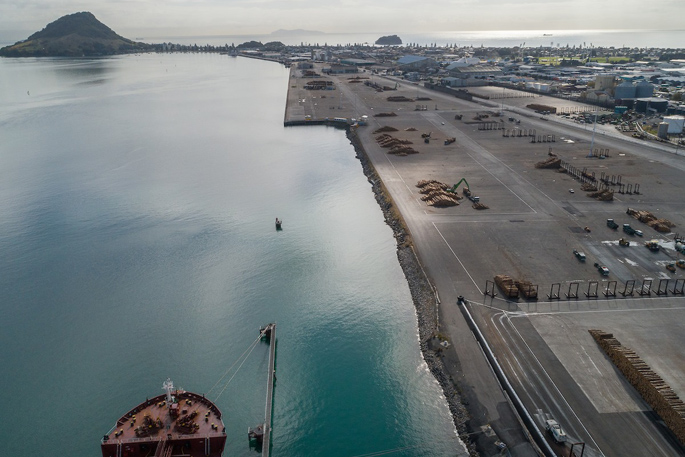Two months since New Zealand moved out of its Covid-19 Level 4 lockdown, marshalling areas at ports are busy again with export cargoes arriving from forests – but one question remains. How strong will China’s demand for logs be in the coming months?
According to the Ministry for Primary’s ‘Economic update for the Primary Industries’ – released mid-June instead of the usual Situation and Outlook for Primary Industries due to situations changing on an almost daily basis and the outlook for sectors more uncertain than ever before – the NZ forestry sector has been significantly impacted by the outbreak and responses; first by China’s lockdown, then NZ’s.
The report says forestry export revenue was down 23 per cent in February, 29 per cent in March, and 62 per cent in April from the same period in 2019.
“Much of the decline in February and March is due to China’s lockdown, but a portion of this is also due to significantly lower prices than the previous year. Forestry exports have been heavily impacted since the start of alert Level 4, with $434 million less revenue – down 39 per cent – compared with the same period last year, and 42 per cent down to China.”
Level 3
Since moving to Level 3 in late-April, forestry export revenue has been able to ramp up, with higher export revenue in the second half of May than the same period in 2019.
“Monthly harvest data from the Forest Growers Levy Trust shows the impact on harvesting. Total harvest volume in April reached just 377,000 cubic metres, 87 per cent down from the same period in 2019.
“The latest market reports show higher log prices in China and lower inventories at Chinese ports. Part of this is down to logs being reallocated across China’s supply chains now their manufacturing sector is operating again.
“China reopened as supplies from NZ and Europe had slowed to a trickle. Log prices at NZ ports are showing an even higher bounce due to lower shipping costs and a lower NZD boosting returns.”
But the report says the big question is what happens once China’s supply chain is back up and running in the next two months.
“That will be determined by the strength of underlying demand in China’s construction sector. And that, in turn, will depend on China’s ability to weather the looming global recession.
“In the wider context, this uncertainty is set against a backdrop of a sharp drop in log prices in mid-2019. “The main driver behind that price fall was surplus supply due to high harvest volumes in NZ and a surge in exports from Europe’s beetle-ravaged forests.
“Prices were in recovery mode in the second half of 2019, but entered the current crisis in a somewhat fragile state.”
Subdued demand
Mark Procter of TPT Forests Ltd, which ships, markets and sells NZ-grown logs for clients around the globe and is one of the two main leasees of storage space at the Port of Tauranga, says customers are happy they’re back in operation post-lockdown that’s for sure.
“However, there is definitely subdued demand right across the world with these uncertain health and economic times.
“The export log markets will not be immune to this uncertainty, so we’re cautious of the current pent-up supply situation and a soft demand environment.”
Pre-Covid, TPT would have typically held approximately 100,000 tonnes at any one time in stock at the Port of Tauranga. “That’s about 300,000 individual logs or 3300 truck-loads.”
“During the very early stages of Level 4 lockdown, exporters were requested to ship as much inventory as possible to make space for essential services supply chains in case the land was required.
“Remember no one knew to what extent and how long Level 4 was going to last. Therefore, we had to assess what cargo we had in stock around NZ and re-organise international customer orders and sales.
“I recall there was only three days from the Government’s announcement to full closure, and so we didn’t necessarily have the right products available in stock to meet the customer orders already committed.
“As well, there were a number of vessels contracted; either already at berth in NZ loading, at berth in NZ discharging cargo and then prepared to load logs, or on the NZ coast waiting in a queue; and even some vessels already on their way from Asia coming to NZ to load logs.
“So there was a significant juggling of inventory, sales, shipping and the requirement to ship to make space for the essential services supply chain.
Level of concern
Once TPT Forests completed this jigsaw it had only 200 tonne “about seven truck-loads” at the port.
That means TPT Forests Ltd shipped about 3300 truck-loads to international customers during the very early stages of Level 4 lockdown, then sat idle for weeks until operations were allowed to resume.
Mark says by the time logs began being exported again after shifting to Level 3 on April 27, there was a level of concern from many international customers “because the supply they relied on stopped – and stopped without notice”.
“We had customers in Korea and Japan that came very close to completely running out of logs to operate their sawmills, plywood mills and MDF mills.
“So if this situation had been extended we certainly would have had customers in trouble, and worse still they may have had to move to another supply source other than NZ, and another species other than Radiata; then New Zealand Inc would have been in a situation of redeveloping the NZ radiata market position once operations resumed.”
Mark says his company is now back to pre-Level 4 lockdown levels after a period of getting forestry operations back underway, clearing the supply chain of log stock that was in the forest before lockdown, and delivering fresh quality logs to domestic customers before export resumed to full capacity.



0 Comments
Leave a Comment